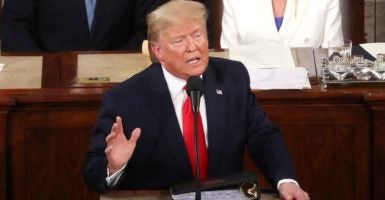In a night of high emotion, President Donald Trump used his third State of the Union address to tout the “great American comeback” during his first three years in office.
Before the night was over, Trump had staged the surprise reunion of a soldier deployed to Afghanistan with his family and announced a scholarship for the daughter of a single mother; first lady Melania Trump had presented legendary talk radio host Rush Limbaugh with the Presidential Medal of Freedom; and House Speaker Nancy Pelosi had ripped up a copy of the president’s remarks.
Trump delivered the address Tuesday night before a joint session of Congress on the eve of his likely acquittal in the Senate impeachment trial. He is only the second president in history, after Bill Clinton in 1999, to make the annual speech during an impeachment trial.
Amid all the emotion, here are some fact checks of key parts of the president’s speech, which lasted about an hour and 18 minutes.
1. “We are restoring our nation’s manufacturing might, even though predictions were that this could never be done. After losing 60,000 factories under the previous two administrations, America has now gained 12,000 new factories under my administration.”
According to Poynter Institute’s PolitiFact in 2017, “the United States has lost more than 60,000 factories since 2001.”
Trump made a similar claim in 2017, mentioned by PolitiFact, laying the blame on China’s joining the World Trade Organization in 2001 for the decline in factories. The president said at a rally in Kentucky: “Since China joined—that’s another beauty—the WTO in 2001, the U.S. has lost many more than 60,000 factories.”
In 2001, there were 397,552 factories in the U.S., according to the Bureau of Labor Statistics. In 2016, there were 343,687. That’s a difference of roughly 54,000.
The first quarter of 2013 saw the lowest number of factories during the George W. Bush-Barack Obama years: 333,565. However, the number of factories began to increase during the final years of the Obama administration.
According to the Bureau of Labor Statistics, 356,046 manufacturing establishments existed in the second quarter of 2019, the most recent quarter available.
In the first quarter of 2017, when Trump took office, there were 343,972. That means there’s now an additional 12,074 new factories.
2. “ … the United States has become the No. 1 producer of oil and natural gas in the world, by far.”
The Trump administration has taken steps to deregulate the oil industry, and the industry has been booming because of technological innovation.
Oil production in particular has exploded in the past decade, thanks largely to the revolution in hydraulic fracking technology that has allowed oil drillers to tap into massive shale oil reserves.
According to The Wall Street Journal, in late 2018 the U.S. became a net exporter of oil for the first time in nearly 75 years:
The U.S. exported 3.2 million barrels of oil a day during the week that ended on Nov. 30, along with about 5.8 million barrels a day of gasoline, diesel, jet fuel and other products. Those exports exceeded combined imports of 8.8 million barrels a day in the week, making the country a net exporter, according to the EIA. This is the first time the U.S. has been a net exporter since at least 1973, federal data show.
More than that, the U.S. also became the world’s largest producer of oil in 2018, according to the Energy Information Administration, as a result of a rapid increase in production that began in 2011.
“U.S. crude oil production, particularly from light sweet crude oil grades, has rapidly increased since 2011,” according to EIA. “Much of the recent growth has occurred in areas such as the Permian region in western Texas and eastern New Mexico, the Federal Offshore Gulf of Mexico, and the Bakken region in North Dakota and Montana.”
The U.S. briefly surpassed Saudi Arabia as the world’s largest oil exporter in June.
In August, the EIA reported, “The United States surpassed Russia in 2011 to become the world’s largest producer of natural gas and surpassed Saudi Arabia in 2018 to become the world’s largest producer of petroleum.”
3. “The unemployment rates for African Americans, Asian Americans, and Hispanic Americans have reached the lowest levels in history. African American youth unemployment has reached an all-time low. The African American poverty rate has declined to the lowest rate ever recorded.”
The Hispanic unemployment rate fell to 3.9% at the end of the the third quarter of 2019, a record low, according to CNBC, which also reported a record low for unemployment for African Americans at 5.5%.
Last year, African American youth unemployment reportedly dropped to the lowest rate since it was first tracked in the early 1970s. In July, the unemployment rate for blacks between ages 16 and 19 dropped to 17.7%.
A total of 762,000 young African Americans had jobs in July 2019. The labor force participation rate fell from 36.3% in July 2018 to 38.8% in July 2019.
The unemployment rate for Asian Americans hit a record low in July 2019, according to the Associated Press, falling to 2.1%.
Trump has talked many times before about the decline in the poverty rate for African Americans. PolitiFact, in 2018, said this is accurate.
4. “Under the last administration, more than 10 million people were added to the food stamp rolls. Under my administration, 7 million Americans have come off of food stamps.”
According to numbers from the Department of Agriculture, 10.7 million more Americans were on food stamps when President Barack Obama left office in January 2017 after eight years. (The official name of the program is the Supplemental Nutrition Assistance Program, or SNAP.)
“In 2009, when Obama entered office, 33,490,000 Americans were on food stamps. Eight years later that number had increased to 44,219,000, an increase of nearly 11 million,” reported The Washington Free Beacon. “Recipients of the program received a monthly benefit of about $125. The Department of Agriculture has noted that changes to food stamp policies made it easier to receive benefits.”
The Agriculture Department recently released numbers showing that 7.7 million fewer Americans receive SNAP benefits than when Trump took office.
The Trump administration restored stricter work requirements for welfare recipients that had been curtailed during Obama’s presidency.
5. “After decades of flat and falling incomes, wages are rising fast, and, wonderfully, they are rising fastest for low-income workers, who have seen a 16% pay increase since my election. This is a blue-collar boom.”
Incomes for low-wage workers have been rising faster than incomes for low-wage workers, a reversal of a long-term trend, according to data from the Federal Reserve Bank of Atlanta.
At the end of 2019, the Atlanta Federal Reserve’s wage-growth tracker showed that “the lowest-paid workers have been experiencing higher median wage growth.”
“[F]or workers in lower-wage jobs, their relative median wage over the 2000s has deteriorated, and that erosion has reversed course only in the last few years,” the Atlanta Federal Reserve said.
“This reverses the pattern seen in the wake of the Great Recession, when median wage growth for lower-paid workers slowed by more than for workers overall.”
The Wall Street Journal reported in December:
Pay for the bottom 25% of wage earners rose 4.5% in November from a year earlier, according to the Federal Reserve Bank of Atlanta. Wages for the top 25% of earners rose 2.9%. Similarly, the Atlanta Fed found wages for low-skilled workers have accelerated since early 2018, and last month matched the pace of high-skill workers for the first time since 2010.
6. “Before I took office, health insurance premiums had more than doubled in just five years. I moved quickly to provide affordable alternatives. Our new plans are up to 60% less expensive.”
Trump was citing numbers from a Department of Health and Human Services study from May 2017 that found average health insurance premiums had doubled since 2013.
The analysis, under the Trump administration, was based on data compiled during the Obama administration and produced by the HHS Office of the Assistant Secretary for Planning and Evaluation.
Specifically, the analysis found that average premiums in the individual market on HealthCare.gov went from an annual $2,784 in 2013 to $5,712 in 2017—an increase of 105%.
In addition, all 39 states using the Obamacare exchanges on HealthCare.gov saw an increase in individual market premiums from 2013 to 2017. Three states—Alaska, Alabama, and Oklahoma—saw premiums triple, the HHS analysis found.
With regard to plans costing 60% less under the Trump administration, the president was referring to a new rule in 2018 that allowed Americans to buy short-term health insurance plans to last for 364 days, and renewable for up to three years.
7. “One hundred thirty-two lawmakers in this room have endorsed legislation to impose a socialist takeover of our health care system, wiping out the private health insurance plans of 180 million Americans.”
In April, Sen. Bernie Sanders, I-Vt., introduced a “Medicare for All” bill alongside 13 other senators.
Unlike Obamacare, which was sold as a program that would not cause Americans to lose their private insurance, the Medicare for All proposal specifically would eliminate private insurance.
Heritage Foundation health care expert Robert Moffit wrote: “Under Section 107, the bill would outlaw private health coverage, including employer-sponsored coverage, that ‘duplicates’ the coverage provided under the government health plan. Approximately 181 million Americans would lose their existing private coverage.”
8. “Over 130 legislators in this chamber have endorsed legislation that would bankrupt our nation by providing free taxpayer-funded health care to millions of illegal aliens, forcing taxpayers to subsidize free care for anyone in the world who unlawfully crosses our borders. “
During a debate in June 2019, every Democratic presidential candidate raised their hands when asked whether they supported taxpayer-funded health care for illegal immigrants.
California became the first state to pass taxpayer-funded health care for illegal immigrants. The New York Times reported that in six states and the District of Columbia, Medicaid covers children regardless of immigration status. So of more than 10 million illegal immigrants in the United States, about 6 million would need health care.
A study by the Center for Immigration Studies determined that government-provided health insurance for illegal immigrants would cost $23 billion per year.
9. “This will be a tremendous boon to our already very strongly guarded southern border where, as we speak, a long, tall, and very powerful wall is being built. We have now completed over 100 miles and will have over 500 miles fully completed by early next year.”
On Jan. 10, Trump’s administration announced a completed 100 miles of wall along the nation’s southern border with Mexico.
Acting Homeland Security Secretary Chad Wolf said: “As of today, we have completed the first 100 miles of new border wall system on the southwest border. New wall has been constructed in every border state from California to Texas.”
10. “Last year, our brave ICE officers arrested more than 120,000 criminal aliens charged with nearly 10,000 burglaries, 5,000 sexual assaults, 45,000 violent assaults, and 2,000 murders.”
In January, Matthew Albence, acting director of U.S. Immigration and Customs Enforcement, said:
We arrested 123,000 people convicted of, or charged with, criminal offenses, and these criminals accounted for almost 500,000 convictions and criminal charges, to include 1,900 homicides 10,000 sexual offenses, 1,800 kidnappings, 45,000 assaults, 74,000 DUIs, 67,000 drug-related offenses, and 8,000 gang members.
According to an ICE report last year, among the 123,000 arrests, 4,736 offenses—including charges and convictions—were related to robbery.
11. “Three years ago, the barbarians of ISIS [also known as the Islamic State] held over 20,000 square miles of territory in Iraq and Syria. Today, the ISIS territorial caliphate has been 100% destroyed, and the founder and leader of ISIS—the bloodthirsty killer [Abu Bakr] al-Baghdadi—is dead.”
The Defense Department reported in December 2018 that the U.S. military, with its partners in the region, “has liberated more than 20,000 square miles of previously held ISIS territory in Syria.”
On Oct. 26, 2019, the Army’s Delta Force killed al-Baghdadi in Syria.





























